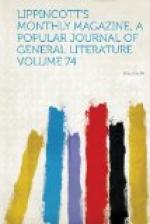[Illustration: MOSQUE OF ST. SOPHIA.]
From the Seraglio we drove to St. Sophia. Stamboul can boast of one fine street, and a few others that are wide enough for carriages. When the government desires to widen a street a convenient fire generally occurs. At the time they proposed to enlarge this, the principal street, it is said the fire broke out simultaneously at many points along the line. As the houses are generally of wood, they burn quickly, and a fire is not easily extinguished by their inefficient fire department. Then the government seizes the necessary ground and widens the street, the owners never receiving any indemnification for their losses. I need not attempt a minute description of St. Sophia. We took the precaution to carry over-shoes, which we put on at the door, instead of being obliged to take off our boots and put on slippers. A firman from the sultan admitted us without difficulty. We admired the one hundred and seventy columns of marble, granite and porphyry, many of which were taken from ancient temples, and gazed up at the lofty dome where the four Christian seraphim executed in mosaic still remain, though the names of the four archangels of the Moslem faith are inscribed underneath them. Behind where the high altar once stood may still be faintly discerned the figure of our Saviour. Several little Turks were studying their Korans, and sometimes whispering and playing much like school-boys at home.
[Illustration: INTERIOR OF THE MOSQUE OF ST. SOPHIA.]
The mosques of Suleiman the Magnificent, Sultan Achmed and Mohammed II. were visited, but next to St. Sophia the mosque which interested me most was one to which we could not gain admittance—a mosque some distance up the Golden Horn, where the sultan is crowned and where the friend of Mohammed and mother of a former sultan are buried. It is considered so very sacred that Christian feet are not allowed to enter even the outer court. As I looked through the grated gate a stout negress passed me and went in. The women go to the mosques at different hours from the men.




